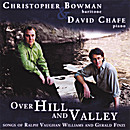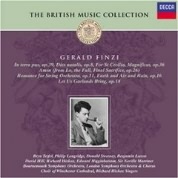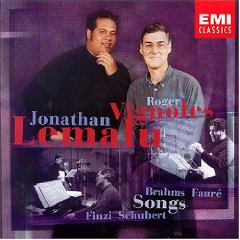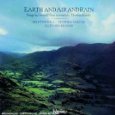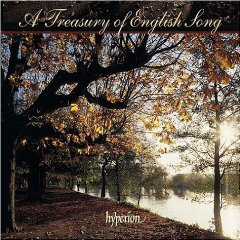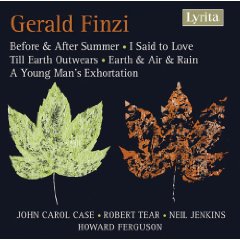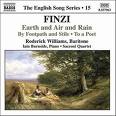Summer Schemes
Poet: Thomas Hardy
Date of poem: undated
Publication date:
Publisher:
Collection: Late Lyrics and Earlier (1922)
History of Poem:
Poem
Summer Schemes
|
||
|---|---|---|
| 1 | When friendly summer calls again. | |
| 2 | Calls again | |
| 3 | Her little fifers to these hills. | |
| 4 | We'll go - we two - to that arched fane | |
| 5 | Of leafage where they prime their bills | |
| 6 | Before they start to flood the plain | |
| 7 | With quavers, minims, shakes, and trills. | |
| 8 | " - We'll go." I sing: but who shall say | |
| 9 | What may not chance before that day! | |
| 10 | And we shall see the waters spring. | |
| 11 | Waters spring | |
| 12 | From chinks the scrubby copses crown: | |
| 13 | And we shall trace their oncreeping | |
| 14 | To where the cascade tumbles down | |
| 15 | And sends the bobbing growths aswing, | |
| 16 | And ferns not quite but almost drown. | |
| 17 | " - We shall." I say: but who may sing | |
| 18 | Of what another moon will bring! | |
(Hardy, 564-5) |
||
Content/Meaning of the Poem:
Speaker:
Setting:
Purpose:
Idea or theme:
Style:
Form:
Synthesis:
Published comments about the poem:
✦✼✦✼✦✼✦✼✦✼✦✼✦✼✦✼✦✼✦✼✦✼✦✼✦✼✦✼✦✼✦✼✦✼✦
✦✼✦✼✦✼✦✼✦✼✦✼✦✼✦✼✦✼✦✼✦✼✦✼✦✼✦✼✦✼✦✼✦✼✦
Musical Analysis
Composition date:
Publication date:
Publisher: Boosey & Hawkes - Distributed by Hal Leonard Corporation
Tonality:
Transposition:
Duration:
Meter:
Tempo:
Form:
Rhythm:
Melody:
Texture:
Vocal Range:
Tessitura:
Dynamic Range:
Accompaniment:
Published comments about the music:
Pedagogical Considerations for Voice Students and Instructors:
✦✼✦✼✦✼✦✼✦✼✦✼✦✼✦✼✦✼✦✼✦✼✦✼✦✼✦✼✦✼✦✼✦✼✦
✦✼✦✼✦✼✦✼✦✼✦✼✦✼✦✼✦✼✦✼✦✼✦✼✦✼✦✼✦✼✦✼✦✼✦
| Pitch Analysis | ||||||
|---|---|---|---|---|---|---|
| pitch | stanza 1 |
stanza 2 |
stanza 3 |
stanza 4 |
total | |
highest |
A |
|||||
G |
||||||
F |
||||||
E |
||||||
D |
||||||
middle C |
||||||
B |
||||||
A |
||||||
G |
||||||
F |
||||||
lowest |
E |
|||||
| Rhythm Duration Analysis of Vocal Line | |||||
|---|---|---|---|---|---|
| stanza 1 | stanza 2 | stanza 3 | stanza 4 | total | |
16th note |
|||||
8th note |
|||||
dotted 8th |
|||||
quarter note |
|||||
dotted quarter |
|||||
triplet |
|||||
half note |
|||||
dotted half |
|||||
stanza total |
|||||
✦✼✦✼✦✼✦✼✦✼✦✼✦✼✦✼✦✼✦✼✦✼✦✼✦✼✦✼✦✼✦✼✦✼✦
Audio Recordings
Over Hill and Valley: Songs of Ralph Vaughan Williams and Gerald Finzi |
|
|
|
The British Music Collection: Gerald Finzi |
|
|
|
Song Recital |
|
|
|
Songs: Brahms - Faure - Finzi - Schubert |
|
|
|
The Songs of Gerald Finzi to Words by Thomas Hardy
|
|
|
|
A Treasury of English Song |
|
|
|
Gerald Finzi |
|
|
|
The English Song Series - 15 |
|
|
|
✦✼✦✼✦✼✦✼✦✼✦✼✦✼✦✼✦✼✦✼✦✼✦✼✦✼✦✼✦✼✦✼✦✼✦
The following is an analysis of Summer Schemes by Gerhardus Daniël Van der Watt. Dr. Van der Watt extended permission to post this excerpt from his dissertation on October 8th, 2010. His dissertation dated November 1996, is entitled:
The Songs of Gerald Finzi (1901-1956) To Poems by Thomas Hardy
This excerpt comes from Volume II and begins on page 162 and concludes on page 170. To view the methodology used within Dr. Van der Watt's dissertation please refer to: Methodology - Van der Watt.
1. Poet
Specific background concerning poem:
"Summer Schemes" comes from Late Lyrics and Earlier (1922) and is undated. In a Apology which prefaces the anthology, Hardy notes the following:
About half the verses that follow were written quite lately. The rest are older, having been held over in MS. when past volumes were published, on considering that these would contain a sufficient number of pages to offer readers at one time, more especially during the distractions of war. The unusually far back poems to be found here are, however, but some that were overlooked in gathering the previous collections. A freshness in them, now unattainable, seemed to make up for their inexperience and to justify their inclusion. A few are dated; the dates of others are not discoverable. (Hardy 1922:i)
2. Poem
SUMMER SCHEMES
|
||
|---|---|---|
| 1 | When friendly summer calls again. | a |
| 2 | Calls again | a |
| 3 | Her little fifers to these hills. | b |
| 4 | We'll go - we two - to that arched fane | a |
| 5 | Of leafage where they prime their bills | b |
| 6 | Before they start to flood the plain | a |
| 7 | With quavers, minims, shakes, and trills. | b |
| 8 | " - We'll go." I sing: but who shall say | c |
| 9 | What may not chance before that day! | c |
| 10 | And we shall see the waters spring. | d |
| 11 | Waters spring | d |
| 12 | From chinks the scrubby copses crown: | e |
| 13 | And we shall trace their on creeping | d |
| 14 | To where the cascade tumbles down | e |
| 15 | And sends the bobbing growths aswing, | d |
| 16 | And ferns not quite but almost drown. | e |
| 17 | " - We shall." I say: but who may sing | d |
| 18 | Of what another moon will bring! | d |
CONTENT/MEANING
Stanza 1 states that when summer comes again nature will awake, birds will sing in the woods and on the plain and the persona and an unspecified friend or lover will venture forth to share in this celebration. In the couplet (1. 8-9) this intention to join in nature's rejoicing is reaffirmed but misgiving is expressed in the proviso that no-one knows what may happen before summer comes.
Stanza 2 traces in some detail what the persona and his companion might do on that day that summer returns. A vivid description is given of water springing from crevices and shaking through the undergrowth to where it cascades down almost drowning the vegetation. A stronger affirmation that the persona and his companion will go into the wood to appreciate these natural wonders occurs in the couplet (1. 17-18) but the doubt or anticipation of what may happen within the next month, is also reaffirmed.
The poet expresses excitement at the prospect of the approaching summer, rejoicing with nature and marvelling at the certainty and consistency of the recurring season. At the same time he is aware of the uncertainty and inconsistency of fate in that man cannot say what may happen even in the immediate future.
A feeling of pleasurable anticipation is only momentarily kept at bay by the intimation that man lacks ultimate control over his future. A positive light heartedness is twice interrupted by mildly soulful introspection.
STYLE
The poetic style is that of a pastoral lyric which mainly deals with nature at its freshest described in delicate and perceptive language which evokes the bright awakenings of early summer. The attractive picture forments the anticipation which comes to a climax with the words " - We'll go" (1. 8) and " - We shall" (1. 17). Both strong affirmations are immediately qualified by the awareness of the persona that such certainty does not lie in his hands.
FORM
The poem consists of 18 lines divided into two symmetrical stanzas of nine lines each (aabababcc ddededeff). The rhyme scheme is tightly knitted and the indented rhyming couplet at the end of each stanza carefully separates the natural image from the reference to the human condition.
3. Synthesis
The style, form and tone support the meaning and message of the poem: the personal is looking forward to the summer but is unsure of what might happen before summer arrives. The personal may well expect something pleasant (he might be planning something secretly, like an engagement). The inversion of words in lines 8 and 17,
"I sing . . . who shall say" (1. 8)
"I say . . . who may sing" (1. 17)
may hint at just that. There is, however, a strong sense of the unknown future lurking so that projected plans may not be realized. ("What may not chance" (1. 9) and "who may sing" (1. 17).)
Setting1. Timbre
VOICE TYPE/RANGE
The song is set for baritone and the range is a perfect twelfth from the second A below middle C.
ACCOMPANIMENT CHARACTERISTICS
The piano accompaniment covers a range of roughly for octaves but the middle range sonority is favoured. Special effects are achieved between bars 15 and 24 where the use of the higher register supports the textual references to bird calls. There is only a single reference to pedal use at the beginning (b. 0). The implication is that the details of pedalling are left to the performer.
Portamento accents occur as reinforcements of vocal melodic instances (b. 8, 11, 12, 46, 50, 58) and also as suggested counter-melodic instances (b. 13, 14, 16, 17, 66, 67). The use of staccato occurs in bars 45 and 53-57 on two-note chords to support the textual meaning which refers to images of light, water and movement. Mezzo-staccato is used on a semiquaver figure (marked distincto) in bars 55 and 57 to support the textual meaning of "aswing". The only use of non-legato occurs in bars 48 and 49 and supports the textual meaning, "we shall trace their oncreeping". There is extensive us of legato slur indications over units of 16 notes and less. Legato playing is thus the main articulation feature of the accompaniment.
The atmosphere created by the piano accompaniment follows the meaning of the text very closely and is largely independent of the vocal material with just enough cross reference to retain unity. The opening 10 bars reflect a clarity and gentle liveliness suggested by the arpeggiated movement. The pastoral feeling is further reinforced by the horn fourths and fifths in bars 6 and 7. A secondary dominant that resolves irregularly, coupled with a slower rhythmic movement in the vocal line in bars 11 and 12, supports the reference to the human element in the poem. Bars 13 - 24 regain a natural vividness through a two-part piano setting and some light dissonances (b. 19, 19, 20, 20, 21, 21, 22, 22) reminiscent of bird calls and other natural sounds ("flood the plain With quavers, minims, shakes and trills.") the chordal treatment, slower rhythmic movement, slower harmonic rhythm and thicker texture all serve to emphasize the reference to the uncertainty of human life described earlier. It is as if the composer with the poet, pauses to stress the importance of the statement. Many suspensions and other non-chordal tones make the harmony of this section more explicitly dissonant within the largely tonal framework. This dissonance supports the idea of the vagaries of human affairs and relationships. Bars 37 - 59 return to the natural setting with a virtual repetition of the opening material up to bar 44. The natural image of burgeoning nature is further supported by the use of staccato chords in bars 45 and 53 -57 and non-legato chords in bars 48 and 49. A joyous impression of an expedition into nature is created. The final section (b. 63 - 67) is a virtual repeat of the previous chordal section (b. 27-36). The codetta for piano alone, briefly tries to recapture the nature image (b. 68 - 69) but is intercepted by a sudden lowered leading note (b. 70). This is retained to bar 73 and creates a tonal uncertainty which finally reaffirms the unpredictability of life and exhibits clearly Finzi's interpretation and intention.
2. Duration
METRE
The text consists of iambic tetrameters virtually throughout with the exception of the two shortened lines (1, 2 and 11). The musical metre varies but is mostly in common time, doing justice to the tetrameters. All metric variations are given on the table below with suggested reasons for the variations.
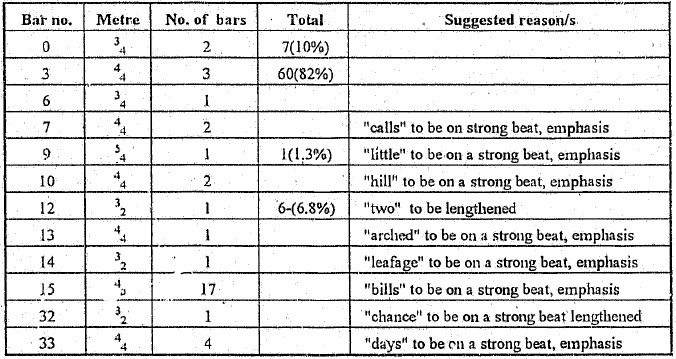
In the total column variations in stanza two have been incorporated since they could be accounted for in the same way. The dominant metre is therefore common time (82% of the bars) and metric variation occurs for the sake of proper declamation of important words, the lengthening of certain words and the accommodation of certain motifs in the accompaniment (b. 0, 3, 6).
Rhythmic motifs
The most prominent rhythmic motif consists of a dotted crotchet and quaver (motif 1) and occurs 20 times (27% of the bars) thus creating a strong sense of unity. Pitches that last longer than a dotted minim, in many cases tied over semi-breves (motif 2) occur frequently at the ends of phrases (9 times). The motif consisting of a quaver and dotted crochet (motif 3) occurs 4 times as a particularly effective settings for certain words.
Rhythmic activity vs. Rhythmic stagnation
Motif 1, being relatively active or lively, is associated with images of the countryside and recurs mostly on occasions where the text refers to nature. Motif 2 is by contrast much more stagnant and is used in the more reflective sections concerning the human element.
Rhythmically perceptive, erroneous and interesting settings
The following words have been perceptively or interestingly dealt with rhythmically:

The only possible rhythmic weakness may be the sustained pitches (motif 2) as they violate the natural speech rhythm of the particular words involved ("hills, shakes, trills, chance, day, crown, down, drown, we, bring.)
Lengthening of voiced consonants
The following words containing voiced consonants have been rhythmically prolonged in order to make the word more singable:
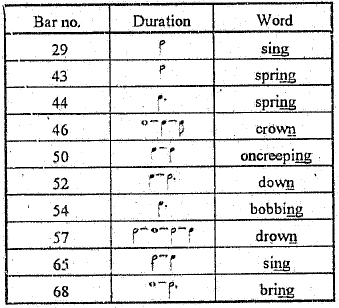
The tempo indication is Allegro ![]() Some seven deviations from this stated indication are to be found in the score. These are listed below, including a possible reason for each deviation.
Some seven deviations from this stated indication are to be found in the score. These are listed below, including a possible reason for each deviation.
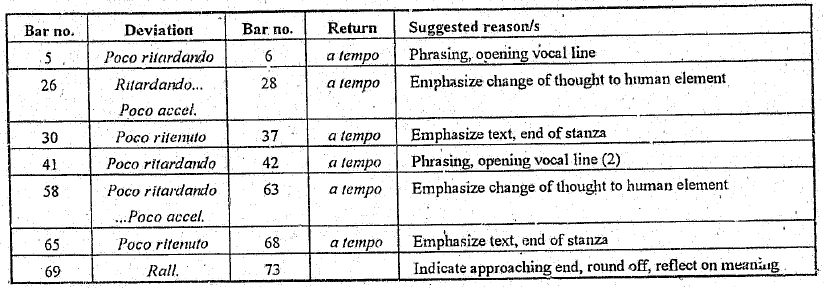
The tempo changes are all functional. They follow the textual meaning closely, mostly emphasizing prominent aspects by slowing down the tempo.
3. Pitch
An interval analysis of the vocal line is represented in the following table:
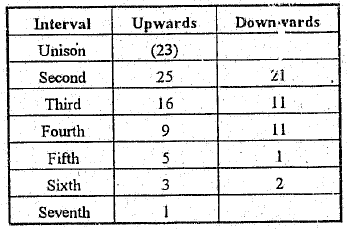
There are 59 rising intervals (45%), 47 falling intervals (36%) and 23 repeated pitches (18%). Smaller intervals (repeated pitches, seconds and thirds constitute the overwhelming majority of the intervals used (96 or 74%), while intervals of a fourth and larger are only 33 or 26% in number. These last two figures indicate the composer's sympathetic treatment of the voice in his setting. In this context it will be worth noting which parts of the text have been highlighted by the use of larger intervals:

It is clear that the composer takes care to set specific words with specific intervals in order to reinforce their meaning and/or to emphasize the meaning they carry of that moment.
Melodic curve
An approximate melodic curve of the vocal line is represented below. Certain words and phrases are indicated to show the relationship between the melodic curve and the meaning:

Primary and secondary climaxes are given below:
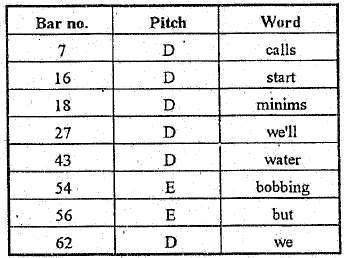
The two highest pitches (b. 54 and 56) are not significantly important in the overall meaning of context. The two important words that are given prominence through pitch level are "We'll". and "We" (b. 27 and 62) which in each case is the start of the reference to the uncertainty of the human condition.
Phrase lengths
Phrase lengths follow the text carefully and there are ample breathing places for a trained singer.
The basic key of the song is D major. The overall impression is certainly tonal without being simplistically so.
Modulation
All modulations are represented in the table below:
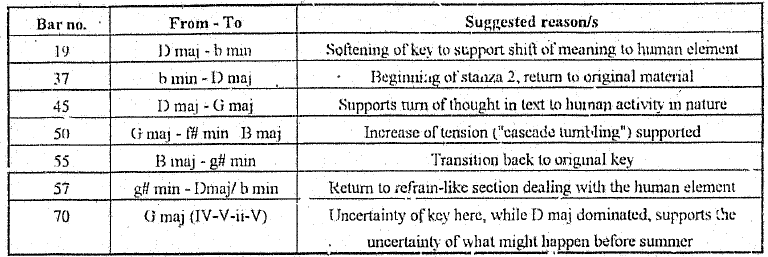
Modulations are functional and carefully follow the meaning of the text. The most interesting modulation is the sudden shift to G major in the fourth-last bar (b. 70). While the song has been fairly clearly in either D major or b minor, the leading note is suddenly lowered in bar 70. Finzi stresses yet again, the meaning of the preceding text and the focal point of the poem, namely the impenetrability of man's future.
Chromaticism/Bi-tonality
No extensive use of chromaticism is to be found in this song. Steps 6 and 7 (rising or falling) are raised in the b minor context (b. 19 - 22). The dissonances that arise here are linked to references in the text to bird calls. In bars 45 - 57 the keys of f sharp minor, B major and g sharp minor follow one another without clearly defined boundaries, hence causing a sense of chromaticism. The lowered leading note in bar 70 produces a modal feeling. There is a bi-tonal effect in bars 19 and 20 where the bass part is in D major and the treble in b minor.
HARMONY AND COUNTERPOINT
Harmonic language
The harmonic language is largely tonal. The harmonic rhythm varies considerably but there is a definite tendency for it to be slower in the sections (b. 27 -36 and 62 - 67) where the text deals with the human condition.
Non-harmonic tones
A variety of non-harmonic tones are used: The only tendency that emerges is the extensive use of suspensions in the above mentioned sections which deal with man rather than nature. Bar 34 is worth mentioning in this regard: in a b minor context a three-part appoggiatura (in the treble) is imposed on a tonic minor chord. The strong emotional effect is further enhanced by the dynamic indication (< >) on the chord.
Harmonic devices
Pedal points in their traditional bass position are not extensively used. They occur in bars 28 - 29 and 35 - 36 where they serve mainly to slow down the harmonic rhythm with the effect as observed earlier. Melodic pedal points occur at five places at the end of a phrase in the vocal line: bars 21 - 23, 33 - 34, 46 - 47, 57 - 59 and 68 - 69. The function seems to be that of rounding off the phrase and emphasizing the textual meaning. Certain words are hereby distorted in terms of their natural speech rhythm.
Counterpoint
Although the vocal line is subtly supported by the highest treble part by the doubling of the melodic pitches, there is no direct imitation between the voice and the piano. There are only slight hints at imitation in the piano part internally (b. 1 and 2 and the parallel place in b. 37 and 38).
The loudness variation is given in the following summary:

FREQUENCY
There are 54 dynamic indications meaning that roughly 74% of the bars contain dynamic indications. There are no separate indications for the voice which seems to imply that the voice should follow those that are noted in the piano score.
RANGE
The highest indicated dynamic level is f (b. 19) and the lowest pp (b. 72). The highest level is used to emphasize the "shakes and trills", giving importance to the world of nature. The lowest level is used in conjunction with tonal uncertainty to reinforce the uncertainty of the human lot.
VARIETY
Indications used are:
![]()
DYNAMIC ACCENTS
Dynamic accents are to be found in three places. The p subito is used twice, in both cases to emphasize the textual meaning relating to the precariousness of man's future. The other dynamic accent is to be found in bar 34 ( mf < ) and was discussed under non-harmonic tones.
DENSITY VARIATION
The density varies loosely between two and seven parts including both piano and voice. The thickness of the piano part is represented in the following table:
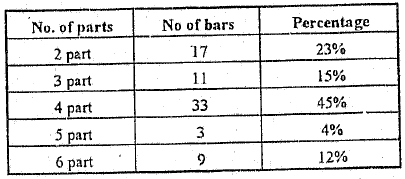
The four-part piano texture is present in almost half of the song, this being the dominant texture. The two-part texture occurs in one localized section (b. 15 - 26) to accentuate the crispness of bird singing. The five- and six-part textures coincide with the refrain-like sections (b. 27 - 36 and 62 - 68) where the thicker, warmer texture supports references in the text to the human condition.
The structure of the song can be represented as follows:

The song has been moulded in the varied strophic form, the two stanzas similarly handled but not identically. The structure reinforces the meaning as can be seen with the divide between stanza and refrain, carrying alternatively the meaning of unreflective nature and the contemplative human element.
7. Mood and atmosphere
The text meaning of the poem falls into two sections:
1. References to an eager anticipation of summer and all it entails.
2. References to human experience of uncertainty against nature's joyous ignorance of it.
Musical sections referring to the former tend to have major or rapidly changing key. They are texturally thinner, rhythmically, melodically and harmonically more active and thus the anticipation, eagerness of and rejoicing in the beauty of nature is supported in the setting. For musical sections referring to the latter, the key tends to be minor, the texture tends to be thicker, the rhythmic, melodic and harmonic material is less active, and in this way the introduced element of doubt is supported by the setting.
General comment on style
The subject matter of the poem is of a pastoral, lyrical nature, exemplifying nature's innocence and beauty and the imminent recurrence of the joyful summer cycle but there are also references to the unpredictability of human affairs and relationships which are in sharp contrast with the simplicity and steadfastness of nature. The discussion shows that this interpretation was indeed in the forefront of the composer's mind when he set the poem to music. The musical style is sensitive to text meaning, and atmosphere and the tonal treatment makes the song directly accessible to the listener.
Unpublished Analysis Excerpts
The following is an analysis of SUMMER SCHEMES by Curtis Alan Scheib. Dr. Scheib extended permission to post this excerpt from his dissertation on February 17th, 2012. His dissertation dated 1999, is entitled:
Gerald Finzi's Songs For Baritone On Texts By Thomas Hardy: An Historical And Literary Analysis And Its Effect On Their Interpretation
This excerpt begins on page thirty-five and concludes on page thirty-six.
Summer Schemes
|
||
|---|---|---|
| 1 | When friendly summer calls again. | |
| 2 | Calls again | |
| 3 | Her little fifers to these hills. | |
| 4 | We'll go - we two - to that arched fane | |
| 5 | Of leafage where they prime their bills | |
| 6 | Before they start to flood the plain | |
| 7 | With quavers, minims, shakes, and trills. | |
| 8 | " - We'll go." I sing: but who shall say | |
| 9 | What may not chance before that day! | |
| 10 | And we shall see the waters spring. | |
| 11 | Waters spring | |
| 12 | From chinks the scrubby copses crown: | |
| 13 | And we shall trace their oncreeping | |
| 14 | To where the cascade tumbles down | |
| 15 | And sends the bobbing growths aswing, | |
| 16 | And ferns not quite but almost drown. | |
| 17 | " - We shall." I say: but who may sing | |
| 18 | Of what another moon will bring! | |
(Hardy, 564-5) |
||
Hardy's poem is in two rather lengthy parallel stanzas, each one being made up of a five-line thesis and a two-line antithesis. Finzi's response tot he generally happy quality of the poem is to place his setting in D major, beginning with a lyrical five-measure introduction in the piano as seen in example 1.
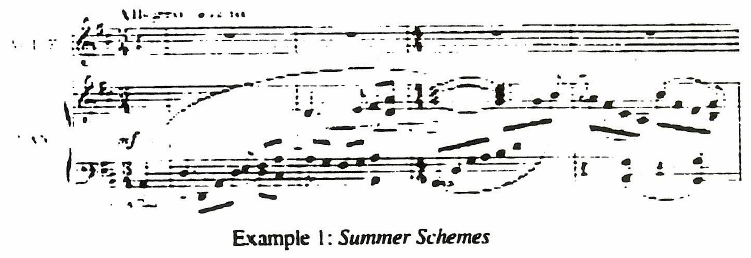
When the voice enters at measure five, the theme is completed (example 2).

In this opening phrase can be seen several characteristics of Finzi's style. The flexible meter, the rise and fall of the line, as well as the setting of only one note per syllable, are all designed to spring from the words themselves and carry their meaning. Supporting this flexible vocal line is a piano part that maintains the eighth-note motion from the opening measures creating a feeling of movement throughout the first five lines of the poem. The motion begins to slow however, as we arrive at the antithetical statement at the end of the verse. Here Finzi suspends the motion to convey Hardy's pondering of what might happen "before that day." The doubt being raised, the music returns to eight-note figuration of the beginning, the musical material going through a descriptive development of sorts as the path of the wqater is traced. The motion again slows for the second antithetical statement and the song ends with a gentle echo of the rising fourth motive from the beginning. Finzi's overall form here is almost sonata-like, the material going through exposition, development and recapitulation, all within a buoyant allegro feeling.
The preceding was an analysis of SUMMER SCHEMES by Curtis Alan Scheib. Dr. Scheib extended permission to post this excerpt from his dissertation on February 17th, 2012. His dissertation dated 1999, is entitled:
Gerald Finzi's Songs For Baritone On Texts By Thomas Hardy: An Historical And Literary Analysis And Its Effect On Their Interpretation
The excerpt begns on page thirty-five and concludes on page thirty-six.

